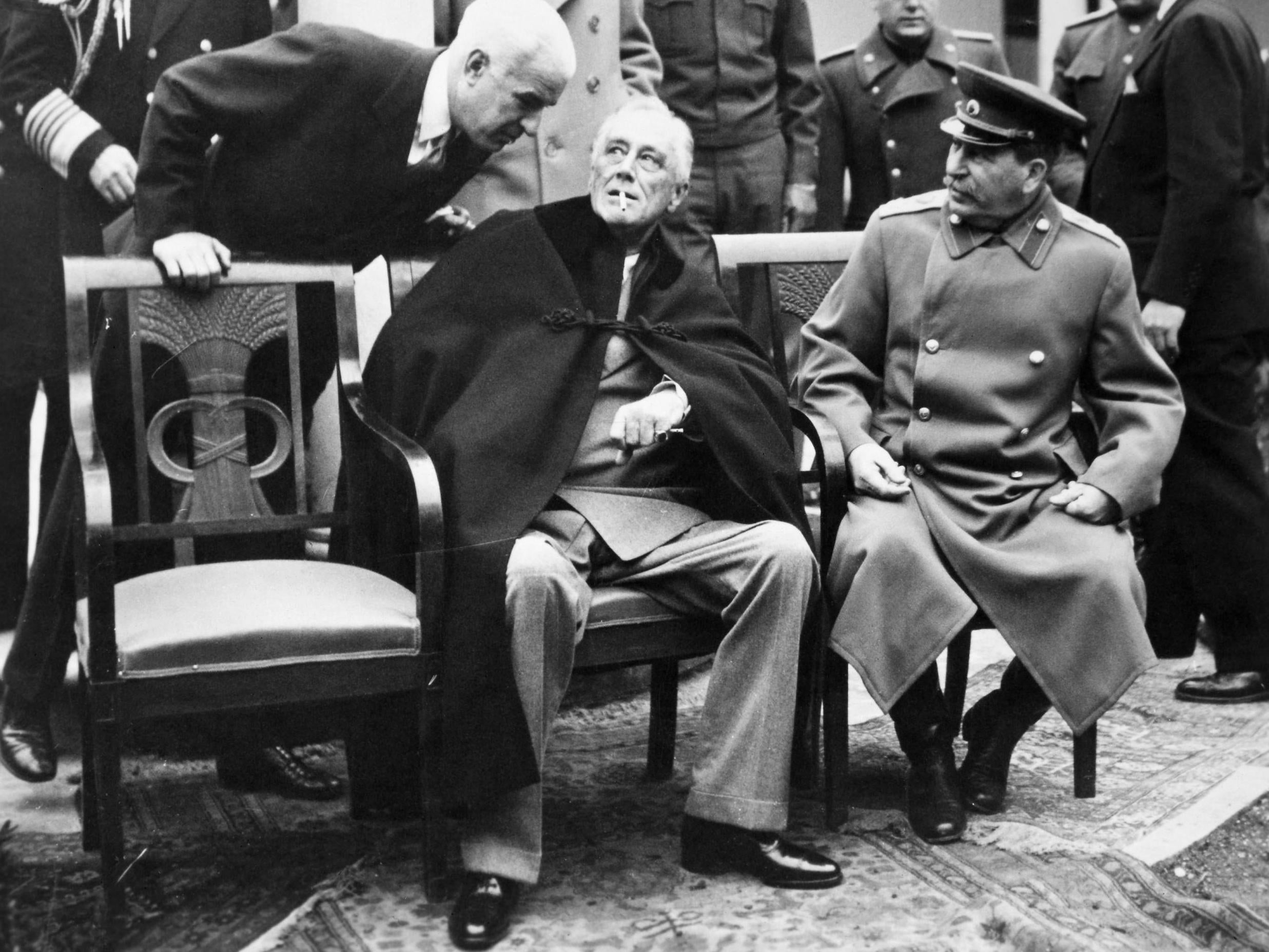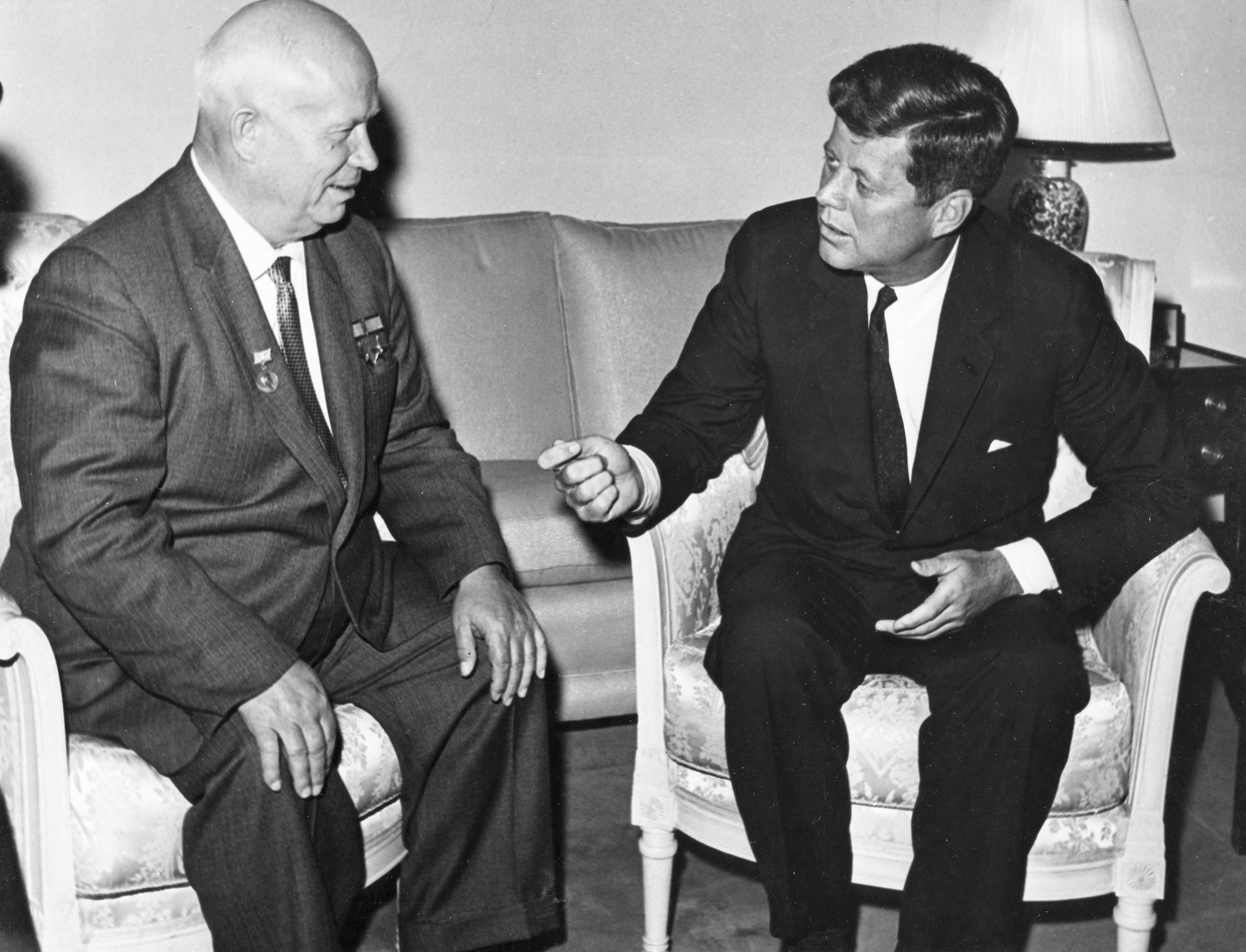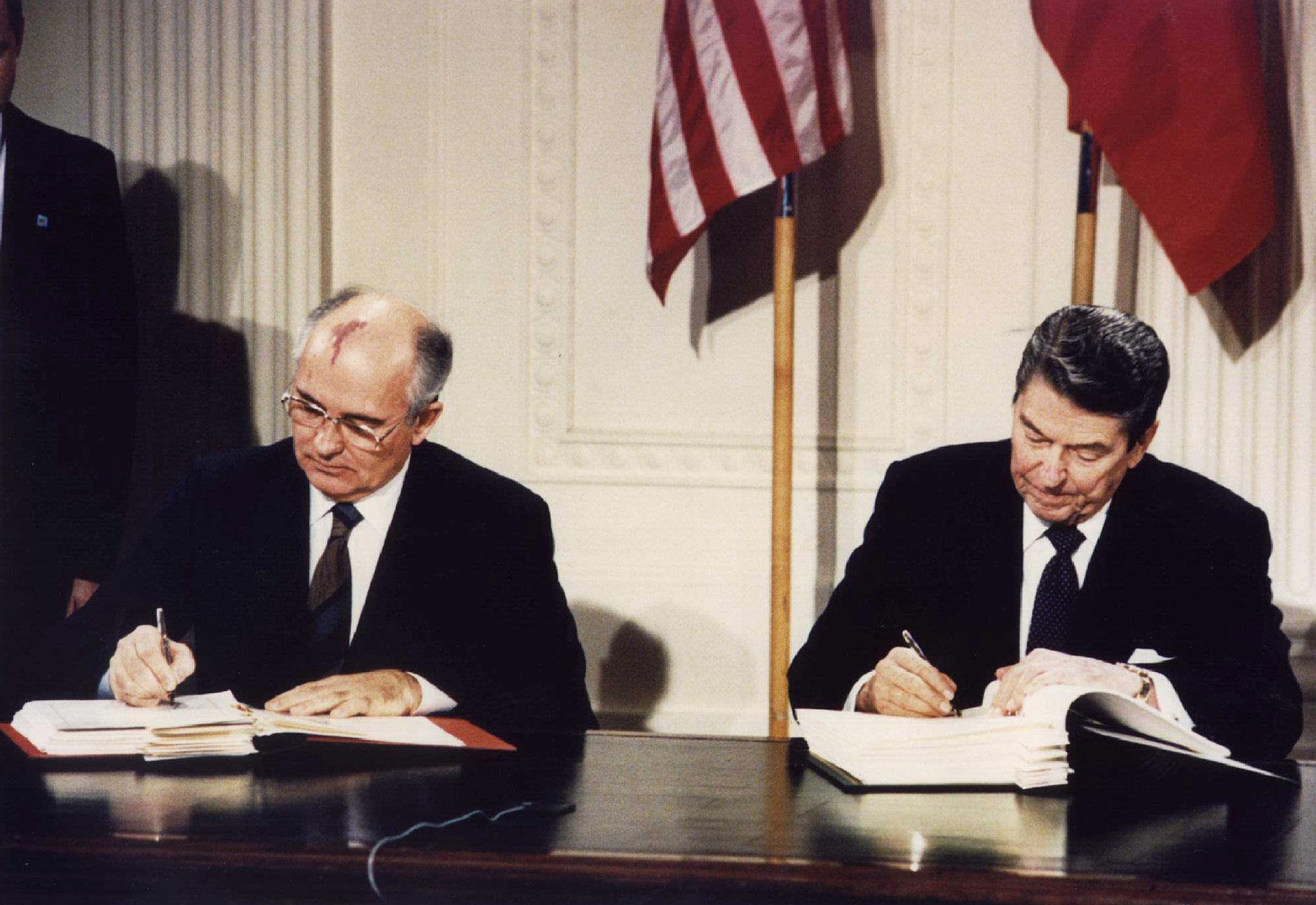Trump-Putin summit: A history of tense meetings between US presidents and Russian premiers
From Second World War allies to nuclear foes, leaders of Washington and the Kremlin have sat down to decide the fate of the world on more than one occasion
Your support helps us to tell the story
From reproductive rights to climate change to Big Tech, The Independent is on the ground when the story is developing. Whether it's investigating the financials of Elon Musk's pro-Trump PAC or producing our latest documentary, 'The A Word', which shines a light on the American women fighting for reproductive rights, we know how important it is to parse out the facts from the messaging.
At such a critical moment in US history, we need reporters on the ground. Your donation allows us to keep sending journalists to speak to both sides of the story.
The Independent is trusted by Americans across the entire political spectrum. And unlike many other quality news outlets, we choose not to lock Americans out of our reporting and analysis with paywalls. We believe quality journalism should be available to everyone, paid for by those who can afford it.
Your support makes all the difference.Donald Trump is meeting Vladimir Putin in the Finnish capital Helsinki today.
Following his visit to the UK to meet Theresa May and the Queen, which is set to spark widespread protests across London, the US president will sit down with his Russian counterpart to discuss an array of geopolitical issues, notably the ongoing civil war in Syria.
The Finland summit – coming against the backdrop of FBI special counsel Robert Mueller’s ongoing investigation into alleged Kremlin attempts to influence the result of the US presidential election in 2016 – will be only the latest in a long series of tense meetings between the two since the outbreak of the Second World War and subsequent Cold War, many of which have served to change the course of world history.
Franklin D Roosevelt’s conference with Soviet leader Joseph Stalin and British prime minister Sir Winston Churchill in Tehran, Iran, in late November 1943 was the first of three between the Allied superpowers during the conflict. The trio discussed strategy and agreed to open a second front against Nazi Germany in order to stretch the latter’s military resources to breaking point.
A German agent, Otto Skorzeny, attempted to blow up the Russian embassy where the talks were being hosted but his planned Operation Long Jump was aborted before he could carry it out after it was uncovered by KGB officer Gevork Vartanyan, tipped off by undercover agent Nikolai Kuznetsov.
In a lighter moment, a suspicious Stalin instructed his local intelligence chief Ivan Argayants to obtain a copy of a memo the premier had seen passed surreptitiously from Roosevelt to Churchill. “Sir, your fly is open”, it read.
The “Big Three” met again in the Black Sea resort of Yalta in Crimea from 4-11 February in 1945. Confident of Germany’s imminent defeat, the trio planned the post-war reorganisation of Europe. Roosevelt also sought Russian support against Japan in the Pacific while Stalin hoped to cement the Soviet Union’s sphere of influence over the Eastern Bloc.

The Declaration of Liberated Europe was signed, promising the people the right “to create democratic institutions of their own choice”, but just five months later the superpowers met again at Potsdam, where the US and Britain confronted Russia over its efforts to install Communism in Poland, Czechoslovakia, Romania, Bulgaria and Hungary.
Harry Truman and Clement Attlee had succeeded the late Roosevelt and Sir Winston (defeated at the ballot box) and agreed the terms for Japan’s surrender, despite President Truman’s relationship with Stalin being frostier than that of his predecessor. The conference concluded on 2 August 1945 and, four days later, Truman ordered that the atomic bomb be dropped on Hiroshima.
The uneasy peace that held during the years of post-war reconstruction was fragile, with the foreign aid the US sowed throughout Western Europe via the Marshall Plan being regarded with hostility by the Kremlin, the Soviet hierarchy believing that Washington’s true purpose was to assert control and build dependent export markets for its goods.
President Dwight D Eisenhower met with premier Nikolai Bulganin, along with British prime minister Anthony Eden and French president Edgar Faure, in Geneva, Switzerland, on 19 July 1955 to discuss co-operation on global security in the age of nuclear paranoia.
The meeting was regarded as a success and inspired a renewed sense of optimism about the possibility of disarmament, prompting the USSR’s new leader Nikita Khrushchev to become the first in his position to set foot on American soil on 15 September 1959 when he spent time with President Eisenhower in Washington and at Camp David in Maryland.
The men professed their hope of securing a “just and lasting peace” but this was dashed when the Soviets shot down a US U-2 reconnaissance plane and captured its pilot, Francis Gary Powers, whose release had to be negotiated in exchange for that of KGB spy Rudolf Abel, then in US custody, as depicted in Steven Spielberg’s 2015 film Bridge of Spies.
Khrushchev left a summit in Paris over the controversy in May 1960. The USSR had been due to meet with Eisenhower, Britain’s Harold Macmillan and French president Charles de Gaulle to bolster “peaceful co-existence” but the U-2 scandal played into the hands of Bolshevik hard-liners critical of “American aggression”, who used it to place renewed pressure on Khrushchev.
The premier nevertheless met with new US president John F Kennedy in Vienna in June 1961, a conference since described as “the most ill-judged summit of the Cold War”. Kennedy had hoped to seal Russian commitment to the Nuclear Test Ban Treaty but instead fell out with Khrushchev over the question of East German sovereignty.

Kennedy, heavily medicated due to recurrent back pain, had been left flustered after almost sitting on Mrs Khrushchev’s lap at a function and was placed on the back-foot by Khrushchev’s accusation that the US intended to “liquidate the Communist system” and his mockery over the Bay of Pigs fiasco in Cuba: “Can six million people really be a threat to the mighty US?”
At 67, Khrushchev was far more experienced and succeeded in outfoxing the 44-year-old president, who beat the car door in frustration as he was driven away from the embassy.
The US president later admitted that the hostility of the occasion had gotten to him: “He beat the hell out of me”.
“I’ve got a terrible problem. If he thinks I’m inexperienced and have no guts, until we remove those ideas we won’t get anywhere with him,” the president told The New York Times reporter James Reston. The construction of the Berlin Wall commenced just months later.
The superpowers did not meet again until 1967. President Lyndon Johnson is credited with improving relations after hosting Alexei Kosgyin at Glassboro State College in small-town New Jersey in June, after the pair were brought together by the outbreak of the Arab-Israeli Six-Day War and Kosygin had arrived in New York to address the UN on the crisis.
Although the US failed to secure Russian support for its military, still mired in Vietnam, the thawing of relations was considered a victory and subsequently dubbed “the Spirit of Glassboro”.
In the early 1970s, their successors Richard Nixon and Leonid Brezhnev met on three occasions – twice in Moscow and once in Washington – and signed several promising treaties, including the Anti-Ballistic Missile Treaty and the Agreement on the Prevention of Nuclear War.
Nixon spoke of his “great hopes” for peace but was forced to resign in disgrace over Watergate on 9 August 1974, bringing an end to a fruitful meeting of minds. However, Gerald Ford and Jimmy Carter subsequently met with Brezhnev in Vladivostok, Helsinki and Vienna and kept the conversation open on arms control and security.
The next decade saw Ronald Reagan and Mikhail Gorbachev really bring the two old foes together. Margaret Thatcher was a close confidante of Reagan and is understood to have encouraged his relationship with the savvy Russian leader with the assurance: “We can do business together”.

Reagan believed that the key to breaking the “suicide pact” of mutually assured destruction lay in warm personal relations and told Gorbachev at their first summit in Geneva in November 1985: “The United States and the Soviet Union are the two greatest countries on earth, the superpowers. They are the only ones who can start World War Three, but also the only two countries that could bring peace to the world”.
The US president sought to persuade Gorbachev that the Russians had historically been too aggressive on the world stage and needlessly paranoid about Washington’s intentions.
Subsequently agreeing in Reykjavik in 1986 on the need to reduce nuclear arsenals, the two disagreed over the Soviet Union’s demand that the US abandon its Strategic Defence Initiative, which would effectively have meant taking the problem of nuclear brinkmanship into outer space.
While no agreement was reached in Iceland, the Intermediate-Range Nuclear Forces Treaty was signed in Washington a year later, scrapping ground-launched ballistic missiles and setting in motion an end to the great arms race. Reagan's “impossible vision” had been realised.
Gorbachev continued to work with the latter's successor George HW Bush on a range of issues, including chemical weapons and the First Gulf War in Iraq, leading up to the disintegration of the stagnating USSR in 1991.
Relations between the newly-formed Russian Federation and its first president Boris Yeltsin were initially good, particularly during the Bill Clinton years.
According to Taylor Branch’s book The Clinton Tapes (2009), when Yeltsin visited the White House in 1993 to express his country’s new commitment to democracy, the Russian was so relaxed he drank himself into a state of confusion and was discovered by security personnel wandering around outside in his underwear, attempting to hail a taxi so that he could go out for pizza.
In the Putin era, the all-powerful Russian premier attended three summits with George W Bush but none with Barack Obama – as Dmitry Medvedev was president when the US and Russia met in Prague on 8 April 2010.
After meeting Mr Putin in Ljubljana, Slovenia, on 16 June 2001, Mr Bush remarked: “I looked the man in the eye. I found him to be very straightforward and trustworthy. We had a very good dialogue. I was able to get a sense of his soul.” Matters subsequently soured over Moscow's disapproval of the War on Terror and US opposition to Russian military intervention in Georgia in 2008.
Mr Putin and Mr Obama did meet at other international gatherings, notably the G20 in Hangzhou, China, in 2016, when the US president expressed concerns about “gaps of trust” existing between the superpowers, particularly with regard to cybersecurity.
Mr Putin’s meeting with President Trump comes at a time when Russia is being hailed on the international stage for its hosting of the FIFA World Cup while simultaneously remaining the subject of deep suspicion over gangsterism at home and political intrigue abroad, notably over the alleged poisoning over of Sergei and Yulia Skripal in Salisbury with the deadly nerve agent novichok.

Join our commenting forum
Join thought-provoking conversations, follow other Independent readers and see their replies
Comments